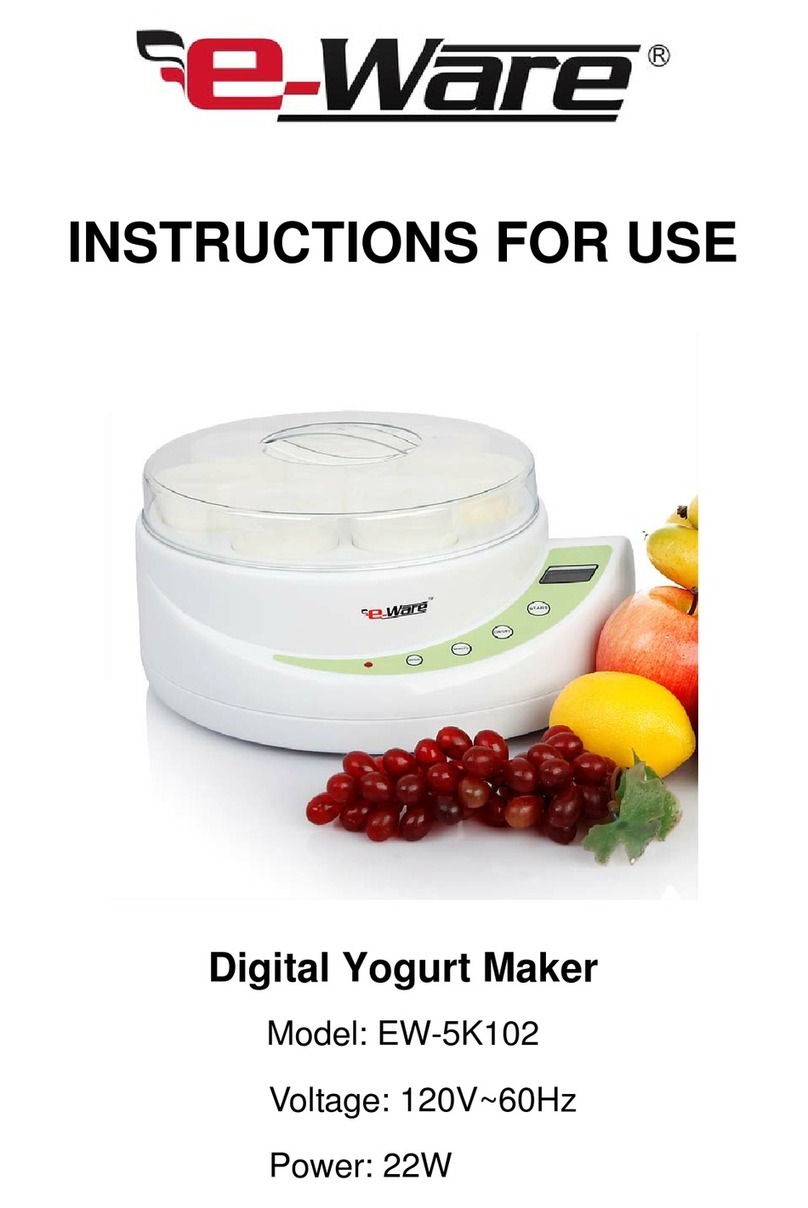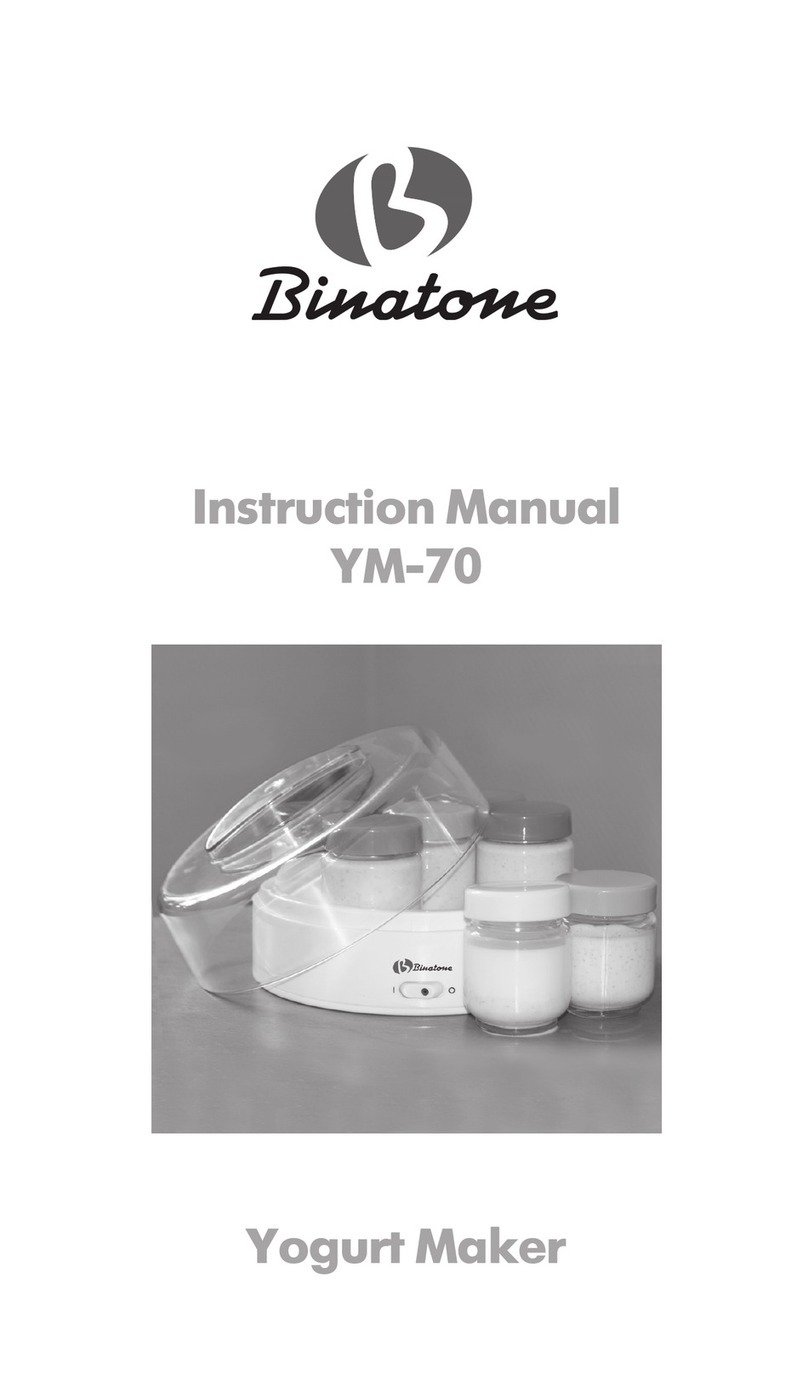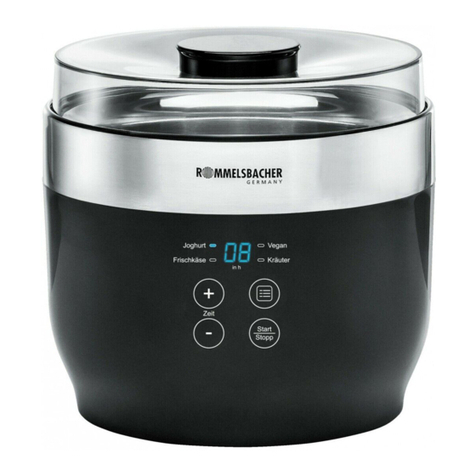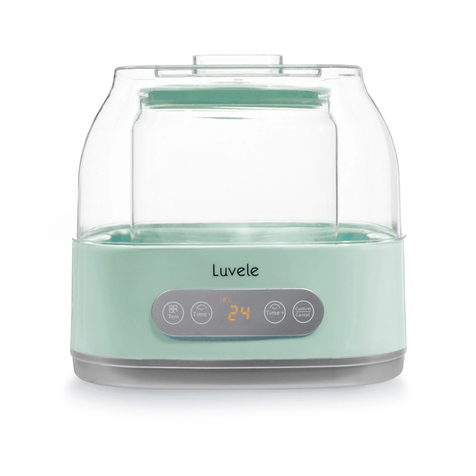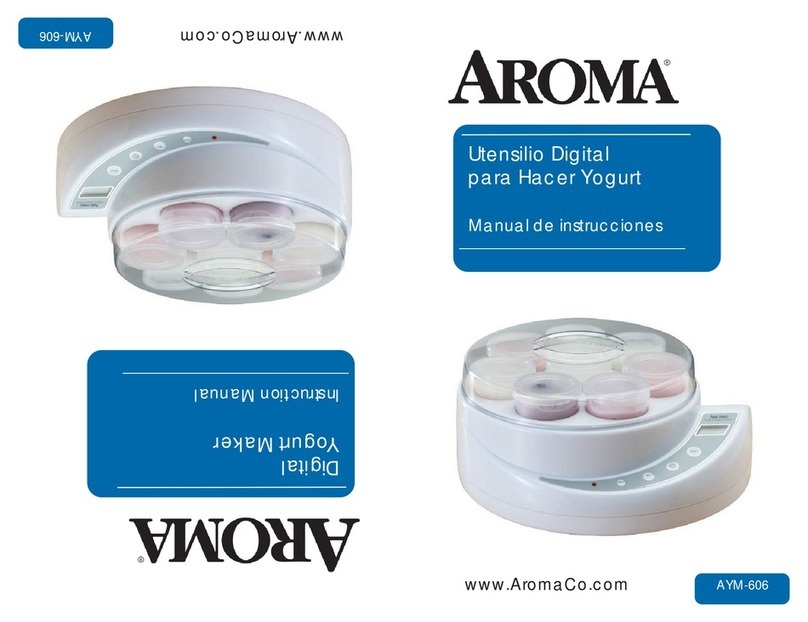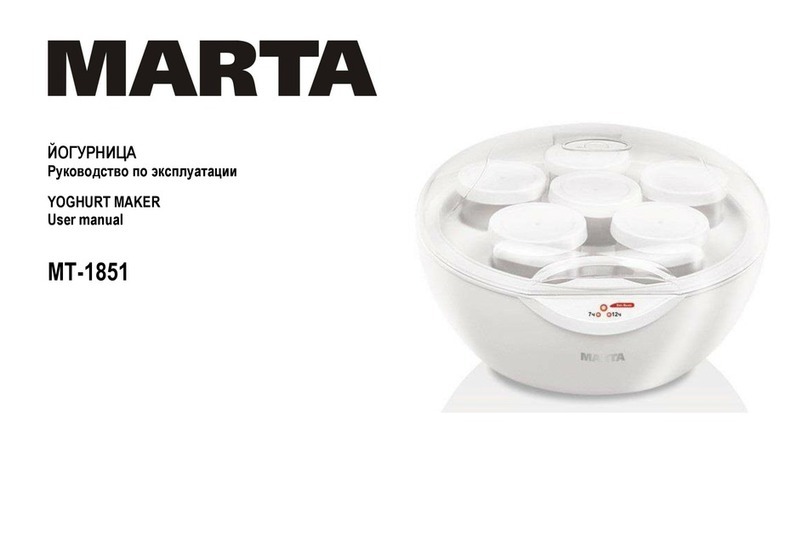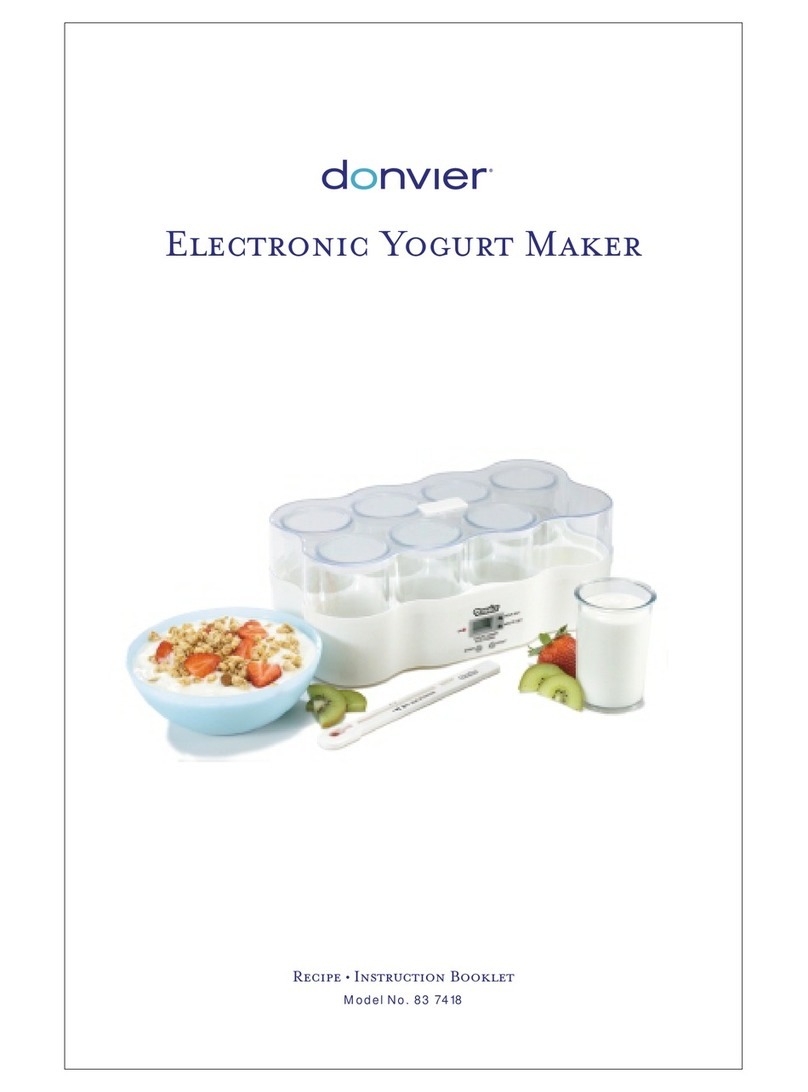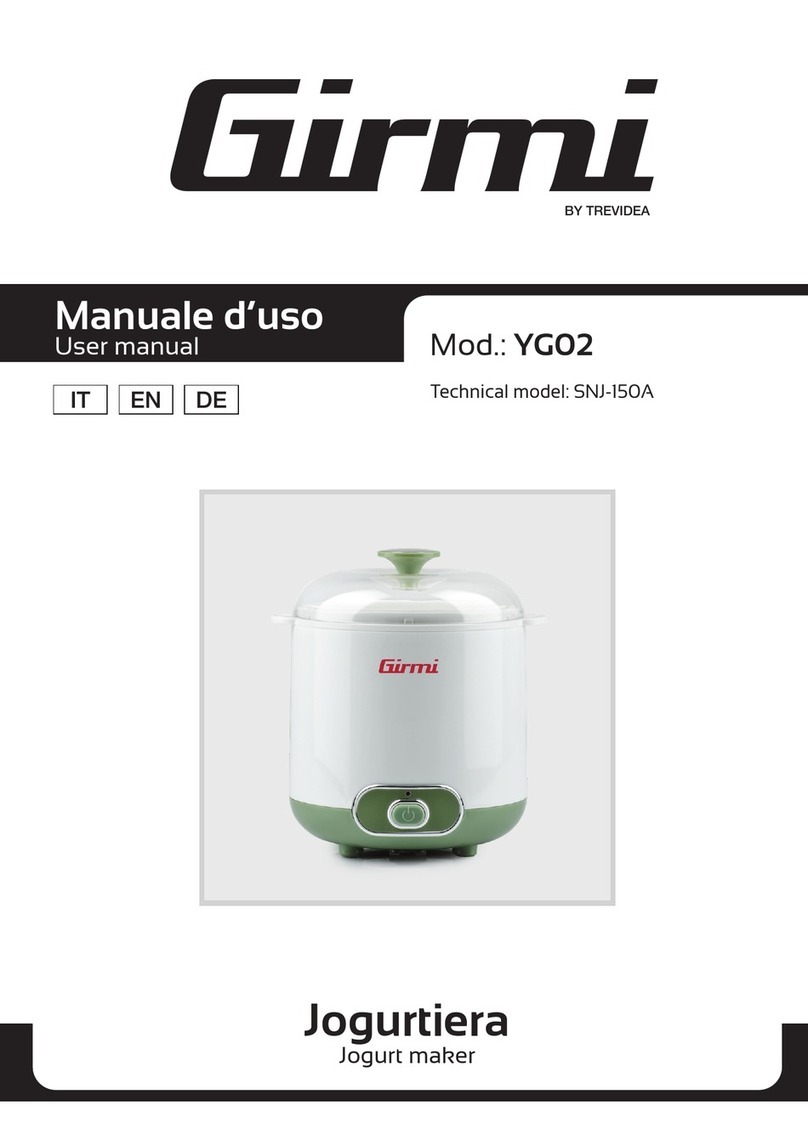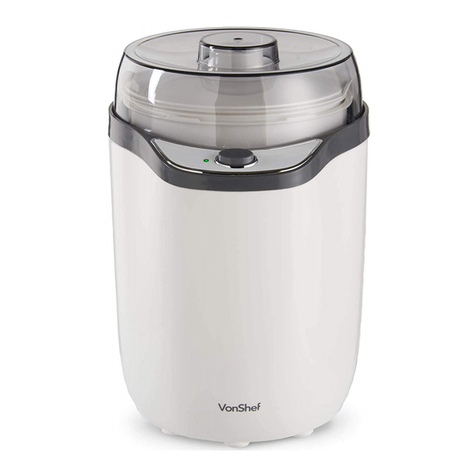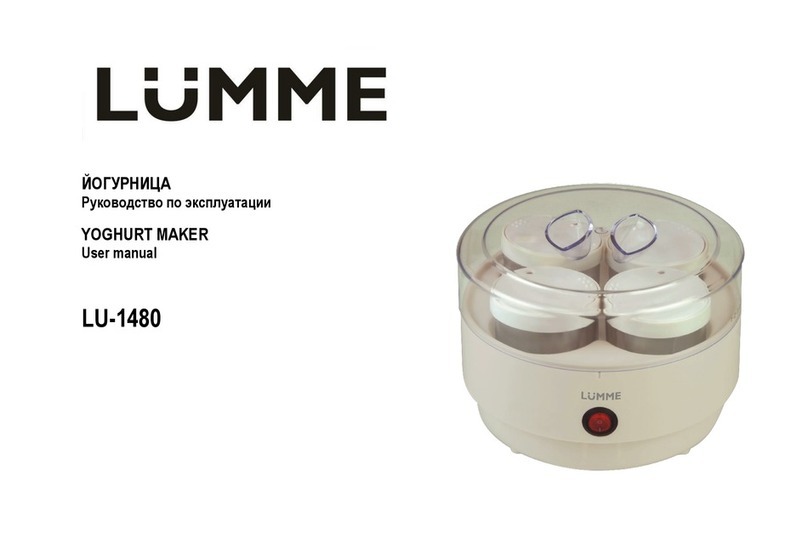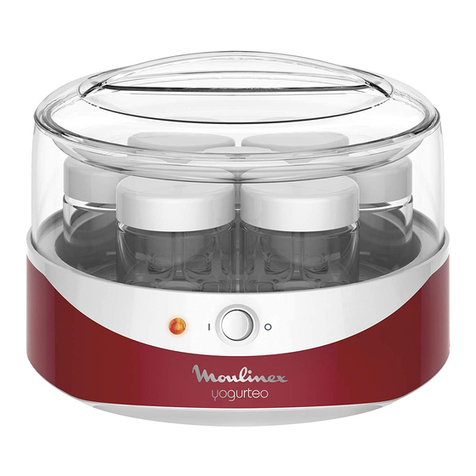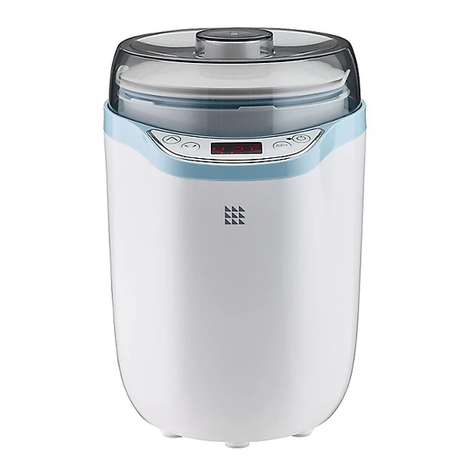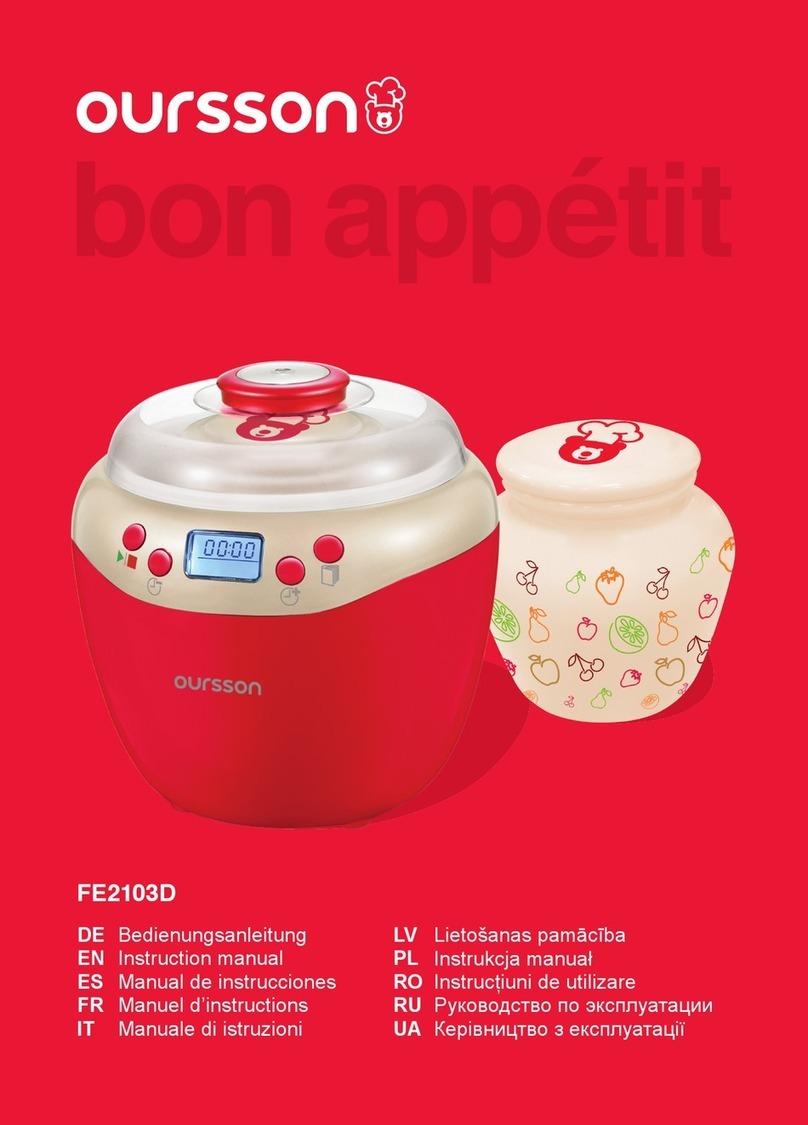e-Ware XJ-5K102 B User manual

INSTRUCTIONS FOR USE
Yogurt Maker
Model : XJ-5K102 B
Voltage: 120V~60Hz
Wattage: 15W

Description
A Lid
B Body
C Pots
D Pot lids
E On/off switch
F Pilot light
Safety advice and warnings
-Read these instructions carefully before switching on the appliance and keep them for
future reference. Failure to follow and observe these instructions may result in an
accident. Failure to follow and observe these instructions may result in an accident.
-Clean all the parts of the product that will be in contact with food, as indicated in the
cleaning section, before use.
Use or working environment:
-Keep the working area clean and well lit. Cluttered and dark areas invite accidents.
-Do not place the appliance on hot surfaces, such as cooking plates, gas burners, ovens
or similar.

-Do not place the appliance where it can reach the sunlight.
-Keep children and bystanders away when using this appliance.
-The appliance should be used and kept over a flat and stable surface.
-The appliance should be situated in a room where the room temperature is between 68ºF
and 89.6ºF. This will enable it to work as efficiently as possible.
Electric safety:
-Do not use the appliance if the cable or plug is damaged.
-Ensure that the voltage indicated on the nameplate matches the mains voltage before
plugging in the appliance.
-The appliance’s plug must fit into the mains socket properly. Do not alter the plug. Do not
use plug adaptors.
-Do not leave the appliance out in the rain or exposed to moisture. If water gets into the
appliance, this will increase the risk of electric shock.
-If any of the appliance casings breaks, immediately disconnect the appliance from the
mains to prevent the possibility of an electric shock.
-Do not use the appliance if it has fallen on the floor, if there are visible signs of damage or
if it has a leak.
-Do not force the electrical wire. Never use the electric wire to lift up, carry or unplug the
appliance.
-Do not wrap the cable around the appliance.
-Do not allow the connection cable to come into contact with the appliance’s hot surfaces.
-Keep the appliance away from heat sources and sharp edges.
-Check the state of the power cord. Damaged or tangled cables increase the risk of electric
shock.
-Do not touch the plug with wet hands.
Personal safety:
-Do not touch metal parts or the body when it is operating, as it may cause serious burns.
-Be careful of residual steam when opening the lid.
Use and care:
-Fully unroll the appliance’s power cable before each use.
-Do not use the appliance when empty.
-Do not use the appliance if the on/off switch does not work.
-Do not move the appliance while in use.
-Disconnect the appliance from the mains when not in use and before undertaking any
cleaning task.
-This appliance is for household use only, not professional or industrial use.
-This appliance is not a toy. Children should be supervised to ensure that they do not play
with the appliance.
-This appliance is intended for adult use. Ensure that this product is not used by the
disabled, children or people unused to its handling.
-This appliance should be stored out of reach of children and/or the disabled.
-Check that the lid is closed properly before starting the appliance.
-Do not use the appliance in damp environments.
Service:
- Any misuse or failure to follow the instructions for use renders the guarantee and the
manufacturer’s liability null and void.

Instructions for use
Before use:
-Make sure that all the product’s packaging has been removed.
-Before using the product for the first time, clean the parts that will come into contact with
food in the manner described in the cleaning section.
-To prepare the yogurts you will need a litre of milk and ferment
* Choosing the milk:
-Preferably choose whole milk or semi-skimmed milk (long life UHT or powdered milk).
This milk doesn’t need to be boiled before being used. Do not use skimmed milk.
-Whole milk will provide more ferments and aromas.
-Fresh or pasteurised milk must be boiled previously. They should be left to cool and the
cream removed. These types of milk contain more vitamins and dietary minerals.
-To obtain thicker yogurts, add 2 or 3 dessert spoons of powdered milk.
-Use the milk at room temperature or heat it slightly (98.6ºF –104ºC).
Choosing the ferment
Choose:
A - Use a yogurt (preferably whole milk yogurt) with an expiration date as far in advance as
possible.
B - Use freeze-dried ferment (it can be purchased in supermarkets, pharmacies or specialist
shops). Respect the activation time recommended on the ferment instructions.
C - Use the yogurt that you have made yourself. Do not use it more than 5 times.
Preparing the yogurt
- Carefully mix a litre of milk with the ferment. To obtain a homogenous mix, beat the yogurt
until the mixture is smooth. Then add the milk while continuing to stir. Make sure froth
doesn’t form.
Starting the machine:
-Unroll the cable completely before plugging it in.
-Connect the appliance to the mains.
-Remove the protective lid (A).
-Put the mixture into the pots (C)
-Place the pots (C), without their lids (D), in the yogurt maker.
-Put the protective lid (A).
-Turn the appliance on using the on/off switch (E).
-The pilot light (F) comes on.
-It will take between 6 and 15 hours to obtain a good yogurt depending on the type of milk
and room temperature.
-Turn the appliance off, using the on/off switch (E).
-Remove the protective lid (A) preventing condensation from getting inside the pots.
-Place the lids on the pots (D).
-Place the pots in the fridge for a minimum of 2 hours before eating. If you wait 24 hours,
they will have a thicker consistency.
Observations:
-Natural yogurts can be kept in the fridge for a maximum of 8 days and other types can be
kept there for 5 days.
-Do not put the appliance in the fridge. Once you have finished using the appliance:
-Unplug the appliance to the mains.
-Clean the appliance

Cleaning
-Disconnect the appliance from the mains and let it cool before undertaking any cleaning
task.
-Clean the equipment with a damp cloth with a few drops of washing-up liquid and then
dry.
-Do not use solvents, or products with an acid or base pH such as bleach, or abrasive
products, for cleaning the appliance.
-Do not submerge the appliance in water or any other liquid, or place it under a running
tap.
-The appliance is suitable for cleaning in hot soapy water or in a dishwasher (using a soft
cleaning program):
zLid (A)
zPots (C)
zPot lids (D)
Anomalies and repair
-Take the appliance to an authorised technical support service if problems arise. Do not try
to dismantle or repair without assistance, as this may be dangerous.
-If the connection to the mains has been damaged, it must be replaced and you should
proceed as you would in the case of damage.
-If any anomaly is detected, check the following table:

Anomalies Causes Solutions
The milk used isn’t
sufficiently rich in proteins.
As semi-skimmed milk was
used, add 2 pots of powdered
milk - 1 pot of semi-skimmed
milk and 1/2 of full milk.
The yogurt maker has been
moved, bumped or vibrated.
Do not move the yogurt
maker during the process.
The ferment is no longer
active.
Change the ferment.
Draft
Do not take out the pots or
open the yogurt maker before
the cycle has ended. Keep
the yogurt maker out of
drafts.
Yogurts are too liquid in
consistency.
Fermentation time too short
Re-connect the appliance.
The milk was too hot.
Next time add the ingredients
at a lower temperature.
The ingredients haven’t been
mixed together enough.
Beat the yogurt until
obtaining a smooth mixture.
Then add the milk while
stirring continuously. Don’t let
froth form.
Lumps
The milk has turned sour.
Check that the milk has not
gone off.
The yogurt has been in the
appliance for too long.
Remove the whey if you wish
or eat the yogurts as they
are. Next time, make sure the
yogurts are taken out of the
yogurt maker earlier.
(Whey) liquid on the surface
of the yogurt.
The milk was too hot when
ferment was added.
Remove the whey if you wish
or eat the yogurts as they
are. Next time, make sure the
ingredients are added at
room temperature.
Yogurts are too acidic.
The yogurt has been in the
appliance for too long.
Reduce the fermentation
time.

RECIPES
Syrup yogurt
•1 litre of milk
•1 natural yogurt or 1 sachet of ferment
•5 dessert spoons of fruit syrup or 4 desert spoons of elderflower syrup Pour the yogurt or
ferment into a container.
Add the syrup and slowly pour in the milk while stirring the mixture continuously. Pour the
mixture into the pots.
Soya yogurt
•1 litre of soya milk
•1 natural yogurt or 1 sachet of ferment
Pour the yogurt or ferment into a container and mix with milk. Pour the mixture into pots.
Pineapple yogurt
•1 litre of milk
•1 natural yogurt or 1 sachet of ferment
•2 slices of pineapple
•4 dessert spoons of pineapple juice.
Cut the slices into small cubes and divide between pots. Pour the yogurt or ferment into a
container. Gradually add the milk and the juice. Pour the mixture into the pots.
Variations: the following fruits can also be used:
strawberries (10 units), mandarins (4 units), orange (1 unit), banana (1 unit).
Note: fresh fruit can be very acidic which can kill off the ferment and prevent the yogurt
making process. To prevent this, add the fruit just before eating or cook it first.
Chocolate or coffee yogurt
•1 litre of milk
•1 natural yogurt or 1 sachet of ferment
•3 dessert spoons of powdered chocolate or chicory.
Pour the chocolate or chicory into a container. Carefully add a glass of warm water and stir.
Add the yogurt or ferment while stirring continuously and add the rest of the milk. Pour the
mixture into pots.
Jam yogurts
•1 litre of milk
•1 natural yogurt or 1 sachet of ferment
•4 dessert spoons of jam.
Mix the jam with a little milk in a container. Add the yogurt or ferment and mix. Add the rest of
the milk and mix. Pour the mixture into the pots.
Table of contents
Other e-Ware Yogurt Maker manuals
